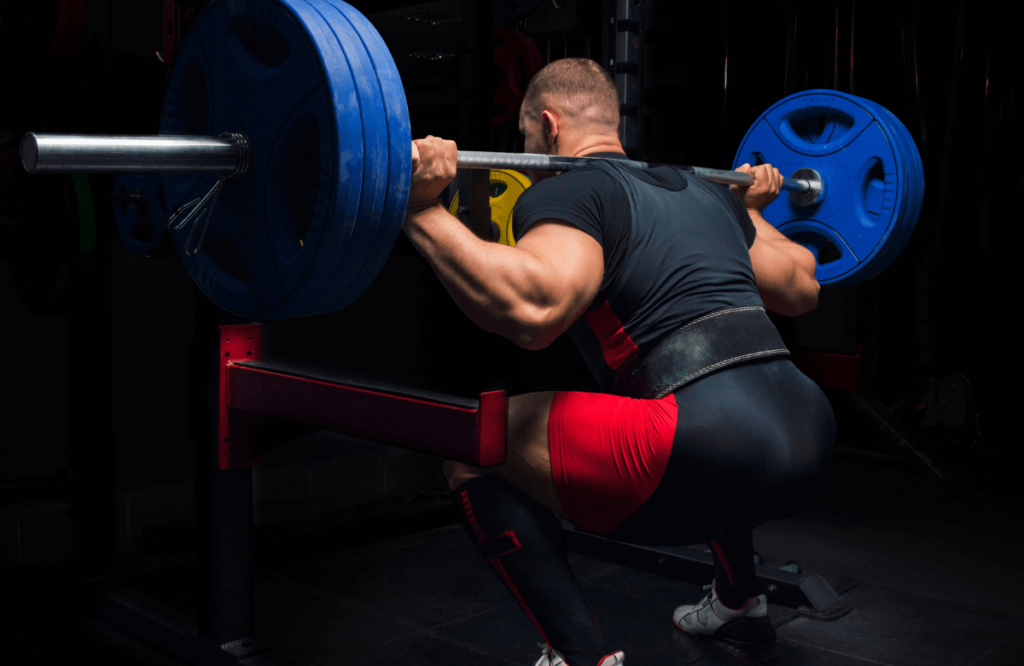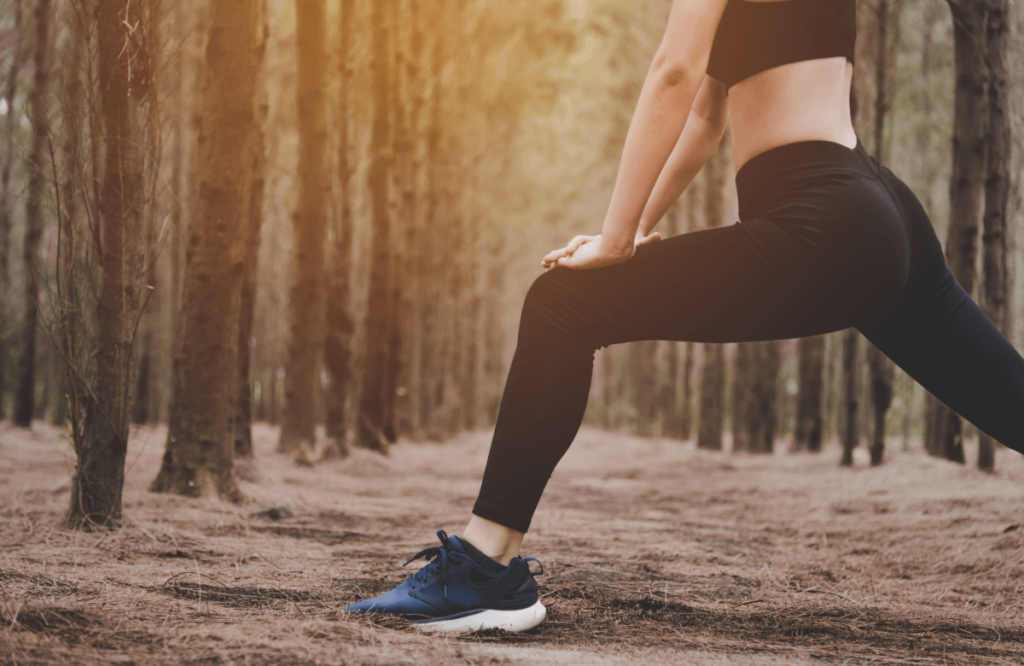Does your inner knee hurt when squatting? If so, you’re not the only one. Knee pain during squatting is common and usually resolves with rest, but it can also signify underlying issues.
You might need to adjust small details in your technique or your weights. Or, you might have an underlying condition that requires professional medical diagnosis and treatment.
Let’s look at the common causes of inner knee pain when squatting, how to resolve them, and when to see a doctor.
Jump to:
What Causes Inner Knee Pain When Squatting?
The knee joint is the largest joint in the human body, allowing you to sit, walk, jump, run, or squat. It contains three muscles, layers of cartilage, tendons, ligaments, and supporting muscles—so it’s easy for something to go awry and cause a knee injury or pain.
Knee pain during the squat position can have several causes, like excess physical activity, repetitive movements, or a more significant problem in the joint.
If you live a sedentary lifestyle, you might have less mobility or range of motion, causing more squat sensitivity. You might notice a dull pain, sore knees, or sharp pain when you exercise.
Meniscus Tear
Meniscus tears are a common injury causing joint pain, stiffness, and swelling. This type of injury can occur from any activity that forcefully twists or rotates the knee, especially if you’re putting your total weight on it.
Essentially, the knee cartilage consists of two C-shaped pieces that act as a support between the thigh and shin bone. A cartilage tear reduces the cushioning, causing pain in the inner knee when you squat or perform daily activities.
In some cases, this type of knee injury can be dealt with at home, but many patients require a physical therapist and adequate recovery time.
Limited Ankle Mobility
Do your knees bend inward, or do your heels lift on the ground when you perform a deep squat?
If so, your knee pain may be from inadequate ankle mobility. These movement patterns can place unnecessary pressure on the knees, causing strain, stiffness, and injury. Limited ankle mobility can also be a symptom of underlying conditions.
Fortunately, there are straightforward, beneficial exercises you can perform at home to reduce ankle stiffness.
Weak Glutes
You might have lagging glutes and hip muscles if you’re new to exercise routines or haven’t trained in a while. Weak glutes and hip muscle strength can cause your knees to cave inward when you squat.
This may place unnecessary stress on your knees over time, leading to painful symptoms.
Reducing weight and focusing on proper form might be beneficial in these cases. Incorporating glute and hip muscle strengthening exercises, like the standing leg raise, may help to relieve knee pain.
Poor Form
Are you using the correct squat form?
You may place additional stress on the knee joint and lower back without the correct technique. This can lead to knee injuries, less range of motion, muscle imbalances, and other complaints.
Issues like heels lifting off the ground and knees caving inward or outward are a few common complaints. Rounding the back and raising the butt first are other common squat mistakes.
Thankfully, these missteps can be addressed with the right squat guidelines and enough practice.
Patellofemoral Pain Syndrome
Patellofemoral Pain Syndrome (PFPS) broadly refers to pain in the front of the knee, around the patella tendon, or kneecap. It’s often called “runner’s knee” or “jumper’s knee” because it’s common in these athletes, but anyone can develop patellofemoral syndrome.
PFPS typically causes a dull ache around these areas and can flare up during athletic activities like squatting, jumping, climbing stairs, and running.
Quadriceps Tendinitis
The quadriceps tendon rests just above the knee cap, connecting the quadriceps muscles to the top of the joint. It allows you to straighten your knee during everyday activities, like walking or climbing stairs.
Like PFPS, quadriceps tendonitis can cause pain just above the knee cap, swelling, stiffness, and other symptoms—all of which make it difficult to squat.
Osteoarthritis
Knee arthritis is prevalent, with 46% of people developing it in their lifetime. Just like a car, your knees and body produce wear over time. Consistent stress on the knee joint from everyday life, like walking, climbing stairs, jumping, and running, can wear out the cartilage over time.
Knee osteoarthritis can make squatting difficult, causing pain, stiffness, swelling, grinding sounds, and other adverse symptoms.
Iliotibial Band Syndrome
Iliotibial Band (IT-Band) Syndrome is another condition that can cause sharp pain in the outer knee and hip. The iliotibial band rests on the outside of the leg muscle, connecting from the top of the pelvic bone down to the knee.
It can rub against the hip or knee, causing swelling, irritation, hip pain, clicking sounds, and other issues.
Like many other medical conditions, you will need a proper diagnosis and potentially see a physical therapist. In some cases, IT-band syndrome requires medications or surgery.
How to Squat Correctly
Before we dive into how to treat knee pain while squatting, it’s essential to freshen up on the correct squat form. Proper form will reduce the chance of injury, strain, or muscle imbalances.
Using a weight, you can maintain proper form for three sets of 3–8 reps is best. The last rep should be a challenge, but you shouldn’t be losing control or need to bail. Here’s how:
Step 1: Set Up the Barbell
Adjust the barbell to a suitable height on the squat rack. It should be a bit lower than shoulder height. You will need enough space behind you to take a few steps backward after unracking the weight.
Step 2: Unrack the Weight
While facing the weight, step under the barbell with both hands on it. Your hands should be a bit wider than shoulder-width distance. Allow the weight to rest on your upper back. Unrack the weight by lifting and taking a few paces backward.
Step 3: Prepare to Squat
Maintain a straight back and stand tall. Your feet should be a bit wider than hip distance, with a slight knee bend. Keep your shoulders directly over the hips without straining your head or neck.
Gently tuck your chin toward your chest. Now, take a deep breath into your abdomen and brace your core.
Step 4: Squat
After taking a deep breath, hinge at your hips and carefully lower yourself. Keep lowering your body until your quads are parallel or a bit below parallel to the ground. Maintain flat feet and even weight distribution.
Pause at the bottom of the squat for a brief moment.
Step 5: Return to the Starting Stance
Now, press through your feet to stand up and return to the starting position.
As you raise your body, ensure your chest is high and squeeze your glutes. As you finish the squat, tighten your glutes and quads while holding a neutral back.
At the end of each squat, the shoulder should be directly over the hips. Take a deep breath into your abdomen and repeat the process for your desired rep range.

How Do You Treat Inner Knee Pain When Squatting?
Experiencing frequent pain and discomfort while squatting is a sign something needs to change. Your knees might need a complete break from heavy movements, or you may need to engage in low-impact alternatives.
Here are a few remedies to consider to get back under the barbell and back to your day-to-day life.
Reduce or Change Activity
Depending on your exercise program and lifestyle, you might need to change or reduce your activities.
If you’re experiencing discomfort when squatting, taking a few sessions off might be best. If the pain is significant, you might limit other physical activities, like hiking, sports, walking, and jogging.
Alternatively, you can change your activities for a short period while you recover. This way, you can still exercise without placing as much stress on the joints. Some low-impact alternatives include the following:
- Swimming
- Pool exercises
- Cycling
- Hip thrusts
- Deadlifts
- Rowing machine
Limiting or changing activities can be especially helpful if you suffer from an overuse injury. However, the right alternatives will depend on your situation, pain level, and fitness goals.
R.I.C.E
Chances are, you’ve heard of the R.I.C.E method. The acronym was introduced in 1978 by Dr. Gabe Mirkin consisting of the four elements of treatment for soft tissue injuries: rest, ice, compression, and elevation:
- Rest: Take a break from the activities that are causing knee pain. This can include physical and daily activities, like squatting, exercise, running, jumping, climbing stairs, and walking.
- Ice: Apply ice packs to the affected area for 10–20 minutes at a time, multiple times each day. Do not place cold packs directly on the skin; cover it with paper towels or cloths.
- Compression: To prevent swelling, wrap your knee in compression bandages. Compression and elastic bandages can be purchased at most drug stores. Don’t wrap your knee too tight, which can cause more pain.
- Elevation: Elevate your knee above your heart whenever you can. This will help get the fluids and blood in the area moving, reducing swelling and pain.
Over-the-Counter Medicine
Over-the-counter (OTC) medication can come in handy for relieving knee and muscle pain. A few standard options that can help ease discomfort and inflammation include the following:
- Advil
- Motrin
- Aleve
- Tylenol
Some of these products include topical options, like creams, gels, and patches. That said, it’s critical to be sure you can safely take these medications, depending on your medical history and other circumstances.
Apply Heat
Applying heat may be helpful if you’re experiencing stiffness or tightness in the joint. Placing a heating pad on your knee for 10 minutes before an activity might help with mobility, flexibility, and range of motion.
The heat can help blood and oxygen flow to the area but might cause more swelling and inflammation.
If you’re uncertain if this is right for you, speak with your primary care provider beforehand.

How to Prevent Inner Knee Pain Going Forward
So, now you’re recovered and ready to hit the weights again—but how do you prevent knee pain in the future?
As the saying goes, “An ounce of prevention is worth a pound of cure.” You can take several steps to strengthen your knees, flexibility, and squat technique to avoid injuries in the future. Here are a few to keep in mind:
Practice Your Technique
It’s critical to practice your squat technique. The proper technique will help you avoid injury, strain, and muscle imbalances and help you develop more strength.
If you’re just starting, do a couple of sets with lighter weights or body weight so you can feel the movement. Try performing squats in front of a mirror to see where you’re going wrong.
If you go to a public gym, you can ask a friend or a staff trainer for feedback. Hiring a personal trainer is another option if you want more detailed directions.
Always Warm-Up
It’s vital to warm up before any training session to reduce the risk of injury or strain. As the phrase suggests, warming up raises your body temperature and gets your blood flowing and your heart pumping.
This can increase your range of motion, flexibility, and performance. But what’s a proper warm-up?
- Do 5–10 minutes of cardio. You can use a treadmill, elliptical, stair climber, jump rope, or any method you prefer.
- Perform a few sets of dynamic stretches. This will take your muscles and joints through the full range of motion, reducing the chance of injury.
- Do pyramid sets. Perform a few sets using lighter weights before your working set. This will prepare your body and mind for heavy weights.
It might seem like a hassle, but warming up is critical for your safety, health, and performance. 10–15 minutes will go a long way in preventing knee pain and strains.
Don’t Overdo It
The temptation to go overboard with heavy weights, lots of sets, and multiple training days can be easy to give in. But, regardless if you’re new to training or a certified gym rat, it’s critical to avoid over-exercising.
Over-exercising can increase the chance of strain and injury, as you’re not giving your muscles enough time to recover. Not only that, you might feel tired or stressed outside of the gym.
Instead, pay attention and listen to your body. Ensure you get 7–9 hours of sleep whenever possible, eat nutritious foods, and take dedicated rest days. This will help you avoid overuse strains and keep you in the gym longer.
Do Targeted Stretches
Incorporating targeted stretches can help build strength and mobility, depending on the cause of the knee pain.
For instance, if you have limited ankle mobility, ankle stretches can help you develop a larger range of motion and more strength.
Other yoga poses and static stretches can help with hip flexibility as well.
Try incorporating targeted stretches before training sessions to enhance performance. Otherwise, you can perform static yoga poses and stretches after sessions or before bed.

Incorporate Other Knee Exercises
If lagging glutes or quads is your issue, incorporating other lower body exercises can help mitigate problems.
Stronger glutes, quads, hamstrings, and calves will make squats easier. Not only will extra movements help you develop strength, but they will provide you with more range of motion and flexibility.
Some fantastic exercises to consider include the following:
- Leg Press
- Glute Bridge
- Hamstring Curls
- Conventional Deadlifts
- Barbell Hip Thrusts
When Should You See a Doctor?
A little pain from time to time typically isn’t a cause for significant concern and resolves itself over time. Changes to your technique activities and getting more rest can often fix the discomfort.
But when should you see a doctor?
If you experience significant pain or swelling that lasts multiple days, it’s best to see your primary care physician. These symptoms can be signs of more significant complications, like underlying conditions, strains, and injuries.
It’s best to avoid squatting and reduce your activity levels while waiting for your evaluation. This way, you can prevent any more issues and get a precise diagnosis of what’s causing the discomfort.
Frequently Asked Questions (FAQ)
Is It OK to Squat With Inner Knee Pain?
When performed correctly, squatting can be tolerated and beneficial for individuals with existing knee conditions or injuries. That said, it depends on the individual, the situation, and the healthcare provider’s recommendations. Stop squatting if you notice significant amounts of pain. If it persists, contact your physician for additional treatment.
Why Does My Inner Knee Hurt When I Squat?
There are several reasons for knee pain when squatting, like overuse injury, incorrect technique, and strain. Other issues, like tendinitis, arthritis, and underlying conditions, can cause discomfort. If you notice pain, try adjusting your technique, taking a break, and speaking with your primary care physician.
How Do I Fix My Inner Knee Pain When Squatting?
First, ensure your knees aren’t caving inward or too far outward. Next, don’t allow your ankles to lift on the ground. If pain persists, you may need to reduce the weight, take a break from exercise, or contact your doctor for additional treatment options.














